
Perusahaan Otomobil Kedua Sendirian Berhad, usually abbreviated to Perodua, is Malaysia's largest car manufacturer, followed by Proton.
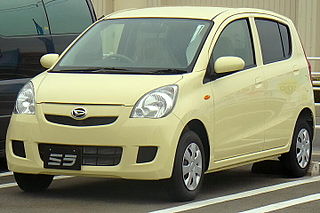
The Daihatsu Mira is a kei car and city car built by Japanese car maker Daihatsu. It has a variety of options and chassis variations, with the latest variant having four models: Mira, Mira AVY, Mira Gino, and Mira VAN. The Mira is the latest successor to the line of cars begun with the Daihatsu Fellow of 1966, and was originally introduced as the commercial version of the Cuore. Outside of Japan, the Mira has also been offered with larger 850 or 1000-cc engines. In Australia, the two-seater version was marketed as the Daihatsu Handivan and later as the Daihatsu Handi. The term mira is Latin meaning "goal" or "purpose".

The Daihatsu Terios is a mini SUV produced by the Japanese automobile manufacturer Daihatsu since 1997 as the successor to the F300 series Rocky. It was initially offered in both short- and long-wheelbase configurations before the former stopped production in 2016 to be replaced by the A200 series Rocky crossover in 2019. The long-wheelbase variant is available mainly for the Indonesian market with three-row seating options. A smaller kei car model called the Terios Kid/Lucia was also available for the first-generation model.

The Proton Waja is a saloon car manufactured by Malaysian automotive company, Proton, it was launched in May 2000 by Prime Minister Mahathir Mohamad.

The Perodua Kelisa is a city car from Malaysian automaker Perodua. It was launched in 2001 as the successor to the Perodua Kancil. The Kelisa was sold alongside the older Kancil, and both were eventually replaced by the Perodua Viva in 2007.
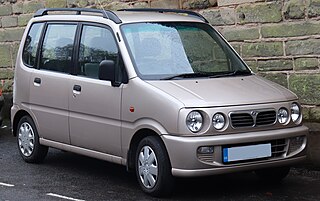
The Perodua Kenari is a city car produced by Malaysian automotive company Perodua. The Kenari is based on the second generation Daihatsu Move kei car (minicar) with a 990 cc DOHC engine powering it. The name Kenari is a Malaysian name equivalent to the word canary, which translates to joy and freedom.
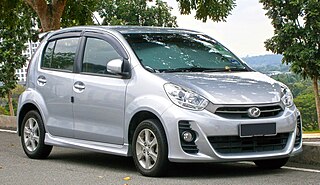
The Perodua Myvi is a subcompact car/supermini (B-segment) produced by the Malaysian manufacturer Perodua since 2005. Based on the Daihatsu Boon, the Myvi is the result of Perodua's collaboration with both Toyota and Daihatsu. However, the third generation Myvi was entirely designed and made in Malaysia, thus not being based on the third generation Boon. The Myvi was the best-selling car in Malaysia for nine consecutive years, between 2006 and 2014, and again between the years 2018 and 2022. The Myvi has been Malaysia's best-selling car for 14 years since its first full year of sales in 2006. As of 2023, the Myvi reached 1.4 million units sold since the launch of its first generation in 2005.

The Perodua Kancil is a city car manufactured by Malaysian automobile manufacturer Perodua from August 1994 to July 2009. The Kancil is a rebadged third generation Daihatsu Mira.

The Toyota Avanza and Daihatsu Xenia are a series of multi-purpose vehicles (MPV) developed by Daihatsu and marketed by both Toyota and Daihatsu, mainly sold with three-row seating. The Avanza and Xenia were developed as an entry-level MPV marketed mainly for the Indonesian and other emerging markets, and mainly produced in Indonesia by Astra Daihatsu Motor. Avanza's spiritual predecessor was the Kijang, whose model program has since been split into two different models to expand Toyota's reach in the MPV sector.

The Toyota KR engine family is a straight-3 piston engine, designed by Daihatsu, a subsidiary of Toyota. The 1KR series uses aluminium engine blocks and chain driven DOHC cylinder heads. It uses multi-point fuel injection, and has 4 valves per cylinder. Some versions have VVT-i variable valve timing. The engine is exceptionally light: 69 kg (152 lb) with all ancillaries. This is due to the nature of the applications and weight of city cars.

The Hyundai Starex is a series of light commercial vehicles built by Hyundai. First-generation models were known in Europe as the Hyundai H-1 and as the Hyundai H200 in the Netherlands. For the second generation, Australian and UK market models are sold as the Hyundai iLoad, in Australia as Hyundai iMax and the UK as Hyundai i800. European models are differentiated as the Hyundai H-1 Cargo and Hyundai H-1 Travel. In the Netherlands, it is called Hyundai H300, in Malaysia, only as Hyundai StarexRoyale with Minivan, while the people mover version of the H300 is sold only for fleets.

The Proton Exora is an automobile produced by the Malaysian car manufacturer Proton. Considered to be a compact multi-purpose vehicle (MPV) in the C-segment, it became Malaysia's first locally developed MPV upon its release on 15 April 2009. The Exora is the first Proton to be based on the P2 platform. Its facelift revision, which debuted on 15 December 2011, became the first Proton to use the CamPro CFE turbocharged engine and CVT technology.

The M500 series Perodua Alza is the first generation of Alza B-segment multi-purpose vehicle (MPV) produced by Malaysian car manufacturer Perodua. Based on the Daihatsu Boon Luminas, it was launched in November 2009 as the company's first purpose-built MPV.

The Daihatsu E-series engine is a range of compact three-cylinder, internal combustion piston engines, designed by Daihatsu, which is a subsidiary of Toyota. The petrol-driven series has cast iron engine blocks and aluminum cylinder heads, and are of either SOHC or DOHC design, with belt driven heads.

The Daihatsu Ayla is a city car designed by Daihatsu and manufactured by Astra Daihatsu Motor in Indonesia since 2013, primarily developed for emerging markets. The Ayla has also been sold by Toyota as the Toyota Agya in Indonesia, South Africa, Tunisia and Americas, and the Toyota Wigo in the Philippines, Sri Lanka, Brunei and Vietnam through an OEM agreement. The car is also slightly reengineered and manufactured in Malaysia by Perodua as the Perodua Axia.
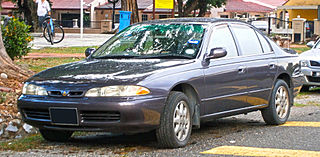
The first generation Proton Perdana is a four-door mid-size family saloon manufactured by Malaysian automobile producer Proton which launched on 26 January 1995. It is a badge engineered seventh generation Mitsubishi Eterna, developed as the result of a collaboration between Proton and Mitsubishi Motors. About 80,000 first generation Proton Perdanas were sold between 1995 and 2013.

The Perodua Axia is a city car produced by Malaysian automobile manufacturer Perodua. It was launched on 15 September 2014 as the successor to the Viva. The car takes over the title of being the most affordable car in Malaysia from the Viva, and the best-selling car in Malaysia for three consecutive years, between 2015 until 2017. The Axia is the first model to debut from Perodua's all-new second factory in Rawang, Selangor. As of mid-2023, the Axia reached 600,000 units sold since the launch of its first generation in 2014.
The automotive industry in Malaysia consists of 27 vehicle producers and over 640 component manufacturers. The Malaysian automotive industry is the third largest in Southeast Asia, and the 23rd largest in the world, with an annual production output of over 500,000 vehicles. The automotive industry contributes 4% or RM 40 billion to Malaysia's GDP, and employs a workforce of over 700,000 throughout a nationwide ecosystem.
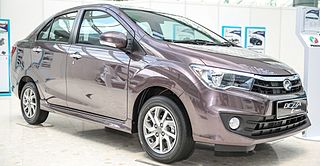
The Perodua Bezza is an A-segment sedan produced by Malaysian automobile manufacturer Perodua. It was launched on 21 July 2016 as Perodua's first sedan car, and a complement to the Axia hatchback.

The A200/A250 seriesDaihatsu Rocky is a subcompact crossover SUV manufactured by Daihatsu. It was unveiled at the 46th Tokyo Motor Show on 23 October 2019 under the "New Compact SUV" name. It replaced the Be‣go in the Japanese market and went on sale on 5 November 2019. The Rocky is also rebadged and sold under Toyota and Subaru brands as the Toyota Raize and Subaru Rex respectively.























